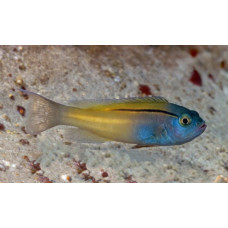Latin name
Meiacanthus nigrolineatus
Other name
Meiacanthus nigrolineatus
Identification
Meiacanthus: Greek, meion = less = lessen + Greek, akantha = thorn.
Blackline Fangblenny have an elongated body shape with a blunt head and large eyes. The body is scaleless. There is no swim bladder.
Features of fish fins
Fish of this species have a large continuous dorsal fin with 3-17 spines.
Fish colouring
Blackline fangblenny are brightly colored. They have a blue head, yellow body and black dorsal fin.
Distribution
Widespread in the western Indian Ocean: Red Sea and Gulf of Aden.
Habitat
A tropical marine reef associated fish.
Size
This species reaches a length of 9.5 centimeters (3.7 inches).
Behavior
Adults swim above the bottom. Juveniles have been observed mixing with apogonids among Diadema spines as a defense against predators such as Pterois.
Food and feeding habits
Adults feed on zooplankton.
Reproduction
Egg-laying. Eggs are bottom-attached and attached to the substrate by a fibrous adhesive pad or support. Larvae are planktonic, often inhabiting shallow coastal waters.
Fishing
This species is commercially important for fishing.
Relationship with a person
Venomous. This poisonous species occasionally enters the aquarium trade.
| Classification | |
| Phylum | Chordata |
| Class | Actinopterygii |
| Squad | Blenniiformes |
| Family | Blenniidae |
| Genus | Meiacanthus |
| Species | M. nigrolineatus |
| Features | |
| Conservation status | Least Concern |
| Habitat | Bottom |
| Life span, years | No information |
| Maximum body weight, kg | No information |
| Maximum length, cm | 9,5 |
| Sailing speed, m/s | No information |
| Threat to people | Not edible |
| Way of eating | Planktonophage |
Blackline fangblenny
Tags: blackline fangblenny

